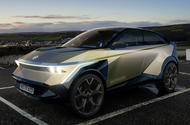Family crossover will go electric yet remain built in UK; designed with focus on aerodynamics
The next-generation electric-only Nissan Qashqai will be designed, engineered and built in Britain – and the company is aiming for it to be priced the same as the current combustion-engined version.
The hugely popular machine helped spark the trend for family SUVs when the first generation launched in 2006 mixing practicality with edgy styling. The third-generation model launched in 2021, and was the best-selling vehicle in the UK last year.
The new model will be styled at Nissan’s UK design studio in London, and will take inspiration from the Hyper Urban concept that was recently shown at the Tokyo motor show. The bold, angular exterior styling of that concept will be retained for the production model, although the radical interior is set to be toned down.
The Qashqai is currently offered with petrol and hybrid powertrains, but the next-generation version – due in the second half of this decade – will only be offered as an electric car. Despite that, Nissan boss Makato Uchida said launching the fourth-generation model at a price equal to the outgoing ICE version was “what we are aiming for, and what our ambition is”. The Qashqai range currently starts at just under £30,000.
Uchida admitted achieving price parity between ICE and EV machines was a challenge, adding: “At one side we talk about scale and how to support that, and on the other side we need supply chains to be established.
“We are at the stage of considering how we are going to make EVs balanced [on price] with ICE. It’s a challenging discussion, because the regulations in each country are not moving at the same pace.”
The Qashqai is currently built at Nissan’s Sunderland plant, and the firm recently confirmed investment of up to £2 billion for its electric successor to be manufactured there alongside the next-generation electric-only Juke and the successor to the Leaf EV.
That £2bn total funding includes direct investment from Nissan in its UK operations of up to £1.19 billion – which includes styling work on the cars at Nissan’s design studio in London, development and prototyping at the Nissan Technical Centre in Cranfield, as well as the cost of retooling and preparing the Sunderland plant for the new platform and bodies.
Nissan has yet to reveal many technical details of the new Qashqai, although it will sit on the Renault-Nissan-Mitsubishi Alliance CMF-EF platform, a bespoke electric architecture designed for C- and D-segment cars. It is already used for the Renault Megane and Renault Scenic, and will also underpin the next-generation Nissan Juke and Nissan Leaf.
Battery packs for the next-gen Qashqai will be built in Sunderland, with Nissan partner AESC planning to build a third battery gigafactory at the site. Nissan and AESC are currently focused on lithium-iron-phosphate (LFP) battery chemistry.
One key focus for the next Qashqai will be on maximising efficiency. Despite the sharp, angular styling of the Hyper Urban David Moss, Nissan’s European research and development chief, told Autocar that the firm has “paid a lot more attention to aerodynamics” than with previous models in a bid to maximise efficiency.”
Nissan has yet to confirm when the next Qashqai will arrive. Based on the current model’s lifecycle it would be expected in around 2029, although that could be adapted depending on the speed of electric car adoption. Nissan is aiming to only sell electric cars in Europe from 2030 onwards, while the UK will ban the sale of all new non-zero emission cars in 2035 – although a new Zero Emission Vehicle (ZEV) mandate will require firms to make an increasing percentage of their sales EVs before then.
But the market in the UK is only one consideration: 80 per cent of the Qashqais built in Sunderland are exported. Company bosses noted there were challenges due to the uneven transition to zero-emission vehicles in different markets – 80 per cent of cars built in Sunderland are exported. It is possible Nissan could continue to produce the existing ICE Qashqai and Juke alongside their successors on the same production lines.
Moss said “the question is whether it creates a level of complexity that becomes unmanageable for ourselves and our suppliers – and what the regulations do.”
He added: “We’d like to switch things cleanly but we recognise that not all of Europe is moving at the same speed. Clearly we want to get the latest models out there and mass-produced to cover the whole market. Like we’ve done with Qashqai: I’m very proud we’ve got the number one car in the UK, and that’s not by chance: our team have really tried to understand what customers want and have kept building on that since the first generation in 2007. It’s about not being complacent, predicting where the market will go and doing the basics well.”







